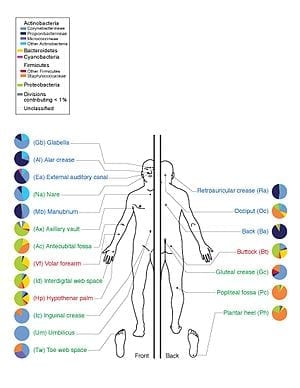Looking at human beings as ecosystems that contain many collaborating and competing species could change the practice of medicine
If the microbiome does turn out to be as important as current research is hinting, then a whole new approach to treatment beckons.
WHAT’S a man? Or, indeed, a woman? Biologically, the answer might seem obvious. A human being is an individual who has grown from a fertilised egg which contained genes from both father and mother. A growing band of biologists, however, think this definition incomplete. They see people not just as individuals, but also as ecosystems. In their view, the descendant of the fertilised egg is merely one component of the system. The others are trillions of bacteria, each equally an individual, which are found in a person’s gut, his mouth, his scalp, his skin and all of the crevices and orifices that subtend from his body’s surface.
A healthy adult human harbours some 100 trillion bacteria in his gut alone. That is ten times as many bacterial cells as he has cells descended from the sperm and egg of his parents. These bugs, moreover, are diverse. Egg and sperm provide about 23,000 different genes. The microbiome, as the body’s commensal bacteria are collectively known, is reckoned to have around 3m. Admittedly, many of those millions are variations on common themes, but equally many are not, and even the number of those that are adds something to the body’s genetic mix.
And it really is a system, for evolution has aligned the interests of host and bugs. In exchange for raw materials and shelter the microbes that live in and on people feed and protect their hosts, and are thus integral to that host’s well-being. Neither wishes the other harm. In bad times, though, this alignment of interest can break down. Then, the microbiome may misbehave in ways which cause disease.
That bacteria can cause disease is no revelation. But the diseases in question are. Often, they are not acute infections of the sort 20th-century medicine has been so good at dealing with (and which have coloured doctors’ views of bacteria in ways that have made medical science slow to appreciate the richness and relevance of people’s microbial ecosystems). They are, rather, the chronic illnesses that are now, at least in the rich world, the main focus of medical attention. For, from obesity and diabetes, via heart disease, asthma and multiple sclerosis, to neurological conditions such as autism, the microbiome seems to play a crucial role.
A bug’s life
One way to think of the microbiome is as an additional human organ, albeit a rather peculiar one. It weighs as much as many organs (about a kilogram, or a bit more than two pounds). And although it is not a distinct structure in the way that a heart or a liver is distinct, an organ does not have to have form and shape to be real. The immune system, for example, consists of cells scattered all around the body but it has the salient feature of an organ, namely that it is an organised system of cells.









